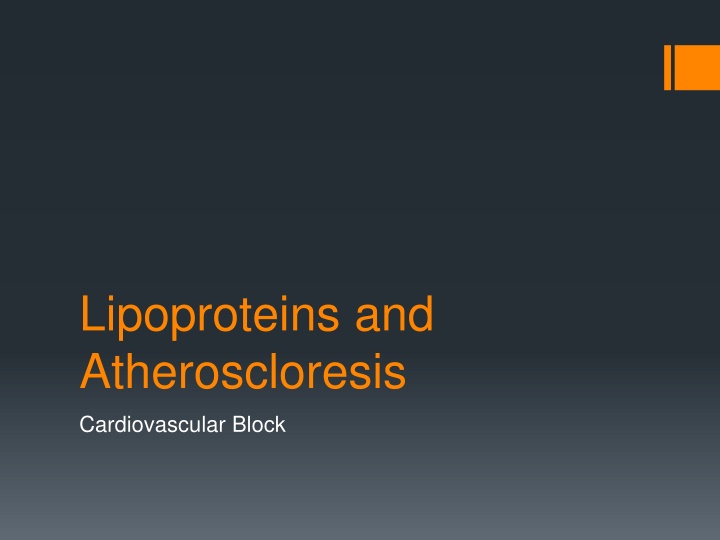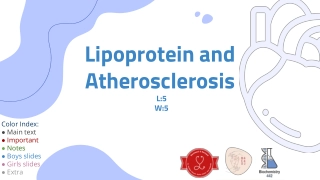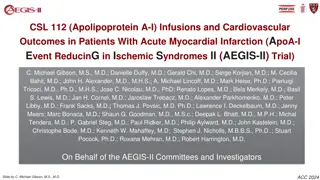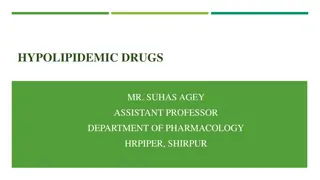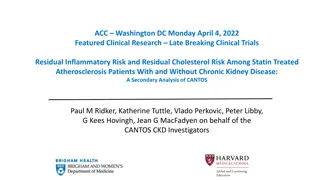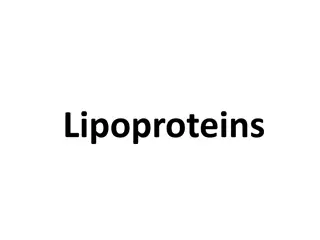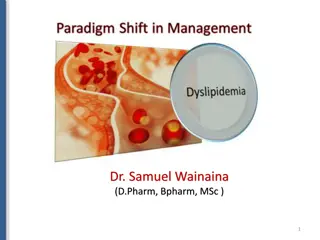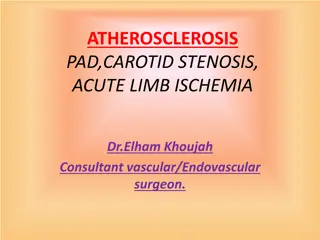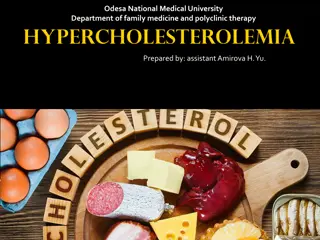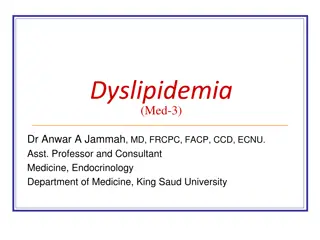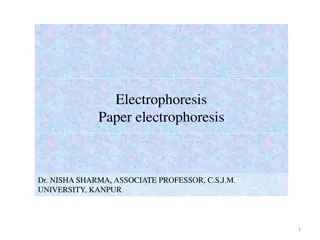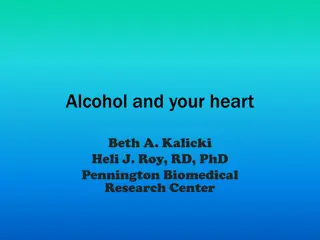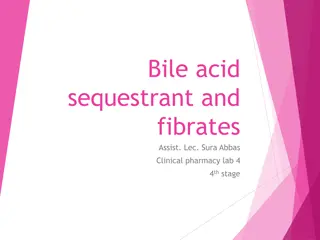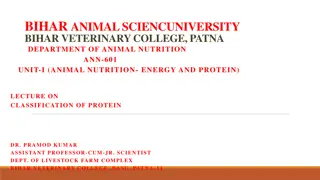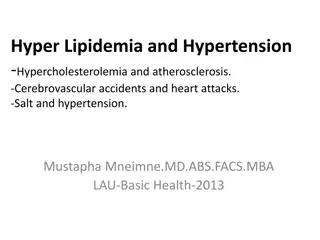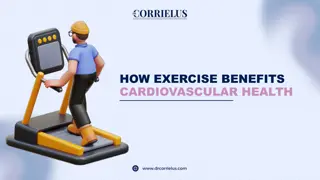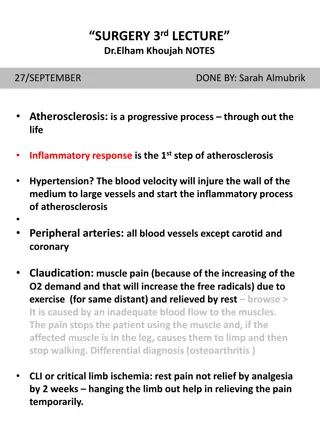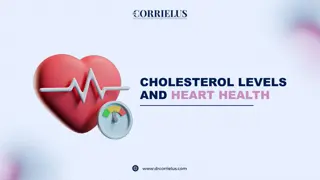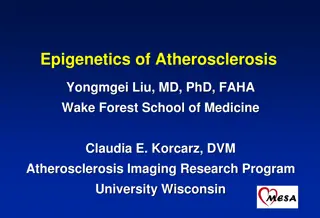Lipoproteins and Atherosclerosis: Understanding LDL and HDL
Correlate lipid metabolism imbalance with atherosclerosis development. Learn about LDL and HDL cholesterol functions, receptor-mediated endocytosis, and regulation. Explore atherosclerosis biochemistry, laboratory investigations, and the role of lipoprotein(a).
Download Presentation

Please find below an Image/Link to download the presentation.
The content on the website is provided AS IS for your information and personal use only. It may not be sold, licensed, or shared on other websites without obtaining consent from the author.If you encounter any issues during the download, it is possible that the publisher has removed the file from their server.
You are allowed to download the files provided on this website for personal or commercial use, subject to the condition that they are used lawfully. All files are the property of their respective owners.
The content on the website is provided AS IS for your information and personal use only. It may not be sold, licensed, or shared on other websites without obtaining consent from the author.
E N D
Presentation Transcript
Lipoproteins and Atheroscloresis Cardiovascular Block
Objectives By the end of this lecture, the First Year students will be able to: Correlate the imbalance in lipoprotein metabolism with the development of atherosclerosis Understand the functions and metabolism of LDL and HDL cholesterol Describe the receptor-mediated endocytosis of LDL and its regulation Recognize how LDL is considered a bad cholesterol whereas HDL a good cholesterol Understand the biochemistry of atherosclerosis and its laboratory investigations Discuss the role of lipoprotein(a) in the development of heart disease
Overview Receptor-mediated endocytosis of LDL and its regulation LDL is bad cholesterol High density lipoprotein (HDL) and its functions Metabolism of HDL HDL is good cholesterol Atherosclerosis Lipoprotein(a)
Receptor-mediated endocytosis of LDL particles Major steps: Binding of Apo B-100 to LDL receptor glycoprotein Endocytosis Endosome formation (LDL vesicle fuses with other vesicles) Separation of LDL from its receptor Receptor is recycled LDL degraded by lysosomes releasing: Free cholesterol, fatty acids, amino acids, phospholipids
Cellular uptake and degradation of LDL particles
Regulation of LDL endocytosis Down regulation: High intracellular cholesterol level causes: Degradation of LDL receptors Inhibition of receptor synthesis at gene level Reduction in cell surface receptors Decreased uptake of LDL by cells Decreased de novo synthesis of cholesterol Up regulation: Low intracellular cholesterol level causes: Recycling of LDL receptors Increased receptor synthesis at gene level Increase in cell surface receptors Increased uptake of LDL by cells Increased de novo synthesis of cholesterol
LDL is bad cholesterol Transports cholesterol to peripheral tissues Elevated LDL levels increased risk for atherosclerosis / heart disease Deficiency or defects in LDL receptors results in: Decreased uptake of cholesterol by cells Increased accumulation of cholesterol in blood vessels Familial hypercholesterolemia Patients are unable to clear LDL from blood Premature atherosclerosis and heart disease
High density lipoprotein (HDL) Nascent HDL: Disk-shaped Contains apo A-I, C-II and E lipoproteins Mainly contains phospholipids Mature HDL: Nascent HDL + cholesteryl esters HDL3 HDL3 + more cholesteryl esters spherical HDL2 HDL2 transfers cholesterol to the liver
Functions of HDL Reservoir of apoproteins (Apo C-II and E) Transports cholesterol to liver from: Peripheral tissues Other lipoproteins Cell membranes Suitable for cholesterol uptake due to: High content of phospholipids Phospholipids solubilize cholesterol and provide fatty acids for cholesterol esterification
HDL is good cholesterol HDL transports cholesterol from peripheral tissues to the liver for degradation Reduces cholesterol level in tissues and circulation (reverse cholesterol transport) High HDL levels have inverse correlation with atherosclerosis Reverse cholesterol transport includes: Cholesterol efflux from peripheral tissues to HDL Cholesterol esterification Binding and transfer of cholesteryl ester-rich HDL2 to liver Release of lipid-depleted HDL3
Atherosclerosis LDL uptake by cells is receptor mediated Additionally, macrophages possess scavenger receptors called scavenger receptor class A (SR-A) The macrophages take up chemically- modified LDL by endocytosis
Atherosclerosis Chemically-modified LDL contains oxidized lipids and Apo B Unlike LDL receptors, the SR-A is not down-regulated in response to high intracellular cholesterol Cholesteryl esters accumulate in macrophages converting to foam cells Foam cells contribute to plaque formation and atherosclerosis
Lab investigations of atherosclerosis Fasting serum lipid profile: TAG level (reflects chylomicron and VLDL levels) LDL, HDL levels Total cholesterol level (reflects LDL, HDL and cholesterol levels) Other tests: Serum lipoprotein electrophoresis Serum apoprotein levels (e.g., apo-B)
Lipoprotein (a) Lp(a) is identical in structure to LDL particle Contains apo(a) in addition to apo B-100 High plasma Lp(a) level is associated with increased risk of coronary heart disease Circulating levels of Lp(a) are determined by: Genetics (mainly) Diet (trans FAs increase Lp(a) levels) Estrogen (decreases Lp(a) levels)
Lipoprotein (a) The apo(a) protein is structurally similar to plasminogen Competes with plasminogen Slows the breakdown of blood clots Triggering heart attack A risk factor for CAD
Take home message Imbalance in the LDL and HDL metabolism causes increased accumulation of lipids in the body LDL is bad cholesterol whereas HDL is good cholesterol The pathogenesis of atherosclerosis includes the uptake of oxidized LDL by macrophages through scavenger receptor class A (SR-A) producing foam cells and atherosclerotic plaque Individuals with high level of plasma Lp (a) are at higher risk for coronary heart disease
References Lippincott s Biochemistry. 6th Edition, Chapter 18, pp. 231-237. Lippincott Williams & Wilkins, New York, USA.
